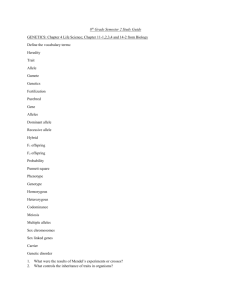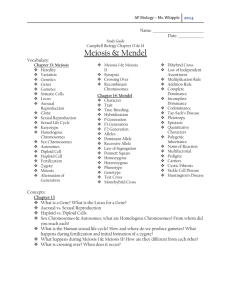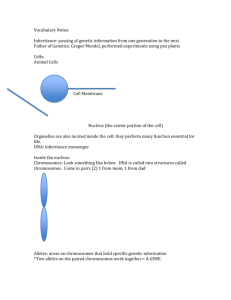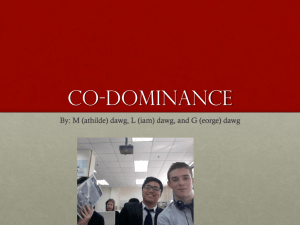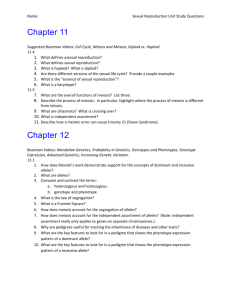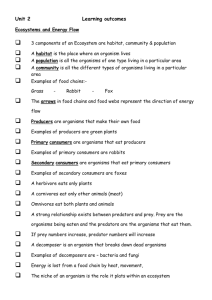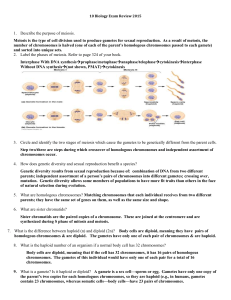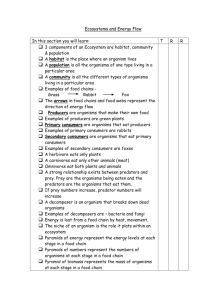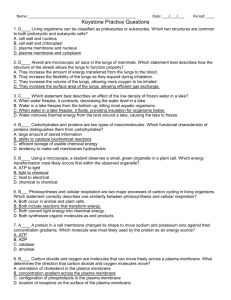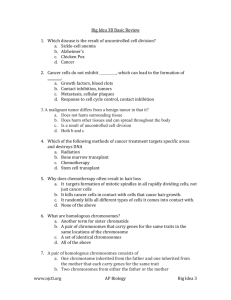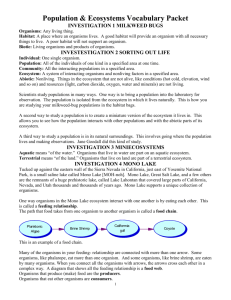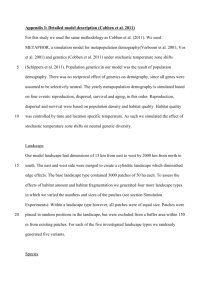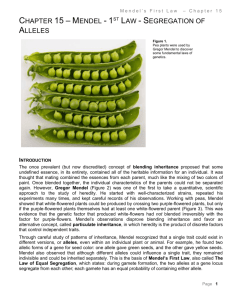Spring Study Guide
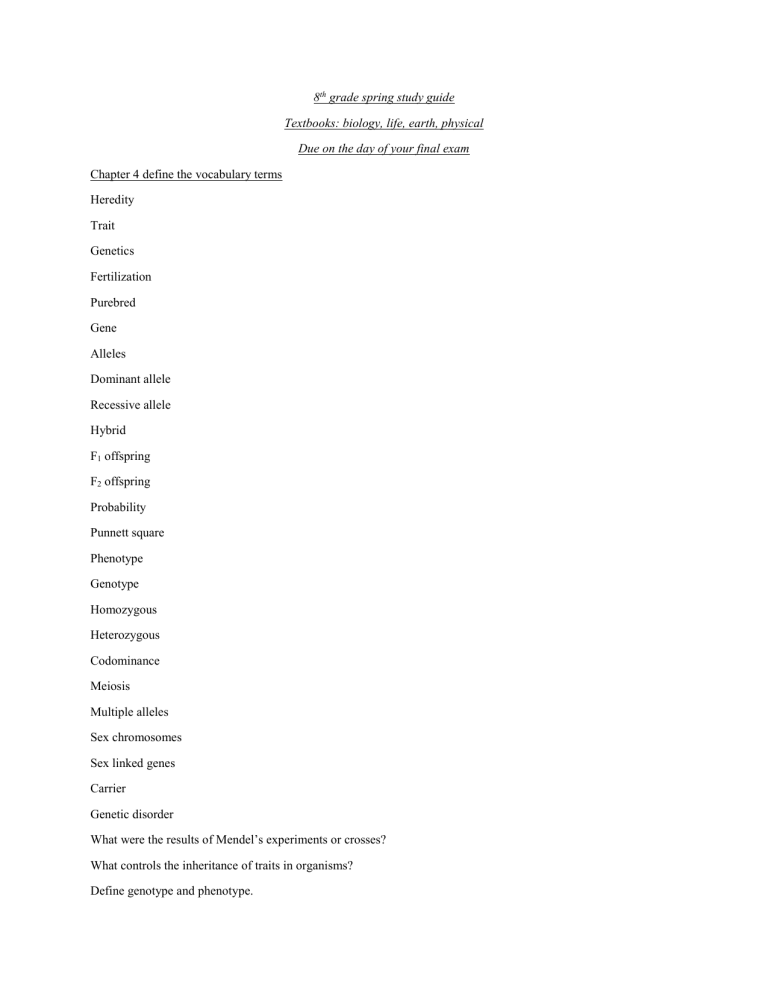
8 th grade spring study guide
Chapter 4 define the vocabulary terms
Textbooks: biology, life, earth, physical
Due on the day of your final exam
Heredity
Trait
Genetics
Fertilization
Purebred
Gene
Alleles
Dominant allele
Recessive allele
Hybrid
F
1
offspring
F
2
offspring
Probability
Punnett square
Phenotype
Genotype
Homozygous
Heterozygous
Codominance
Meiosis
Multiple alleles
Sex chromosomes
Sex linked genes
Carrier
Genetic disorder
What were the results of Mendel’s experiments or crosses?
What controls the inheritance of traits in organisms?
Define genotype and phenotype.
What is codominance? Gove an example of codominant alleles and explain how they are codominant.
Explain how two organisms can have the same phenotype but different genotypes? Give an example.
What role do chromosomes play in inheritance?
Briefly describe meiosis I and meiosis II.
What is the relationship between alleles and chromosomes?
How many sex chromosomes are produced at the end of meiosis?
What forms the genetic code?
How does a mutation in a gene affect the order of DNA bases?
Describe what happens when Mendel crossed purebred tall pea plants with purebred short pea plants.
You toss a coin five times and it lands heads up each time. What is the probability that it will land head up on the sixth toss?
What is the relationship between genes and the environment?
Complete the table below:
Alleles of blood type
Blood Type Combination of Alleles
What is the sex of a person who is a carrier for colorblindness?
What are the functions of sex chromosomes?
Identify two major causes of genetic disorders in humans.
Chapter 23 define the vocabulary terms
Biodiversity
Extinction
Endangered species
Threatened species
Habitat destruction
Habitat fragmentation
Poaching
Captive breeding
Invasive and exotic species
How has the number of species becoming extinct changed in the last few years?
Food web
Energy pyramid
Producers
Consumers
Ecosystem
Estimate
Birth rate
Death rate
Immigration
Emigration
Population density
Limiting factor
Carrying capacity
Natural selection
Charles Darwin
Evolution
Adaptations
In what ways is biodiversity valuable?
How does habitat fragmentation contribute to extinction?
List three factors that could affect the biodiversity in an ecosystem.
Explain how human population growth affect resource use and pollution.
Describe how an exotic species can threaten other species in an ecosystem.
Chapter 21 define the vocabulary terms
Organism
Habitat
Biotic factor
Abiotic factor
Species
Population
Community
Ecology
Food chain
Niche
Competition
Predation
Symbiosis and the three interactions
Which method would you use to determine the number of mushrooms growing on the floor of a large forest?
List the three types of symbiotic relationships and explain how the two organisms are affected.
Name three limiting factors for populations.
How might a change in one population affect the other populations in a community?
What are some biotic factors in the habitat of a field mouse?
What important observations did Darwin make on his voyage?
How does natural selection lead to evolution?
Describe a food chain of which you are a member.
Why are there usually a few organisms at the top of an energy pyramid?
Chapter 3 biology textbook and life science textbook define the vocabulary terms
Biogeochemical
Water cycle
Carbon cycle
Nitrogen cycle
Nutrient cycles
How are evaporation and transpiration related?
How does the way that matter flows through an ecosystem differ from the way that energy flows?
Why do living organisms need nutrients?
Explain how a nutrient can be a limiting factor in an ecosystem.
What role do producers play in the carbon and oxygen cycles?
Name and describe the processes involved in the water cycle.
Microscopes
What are the parts of a microscope?
How do you focus a slide?
Describe how to prepare a wet mount slide.
Laboratory safety
Describe safe behavior and appropriate procedures in all science inquiry.
Scientific Inquiry
Explain the role of a hypothesis in a scientific inquiry
Explain the differences between variables: independent, dependent, and controls
How is data communicated?
Make and label a bar, line, and pie graph
Convert measurements to different metric units ( KHDUDCM)
Chapter 9 define the vocabulary terms
Motion
Reference point
Speed
Average speed
Instantaneous speed
Velocity
Acceleration
When is an object in motion?
How do you know an object’s speed and velocity?
The rise of a line on a distance time graph is 600 m and the run is 3 minutes. What is the slope of the line?
What graphs can be used to analyze the motion of an accelerating object?
How can a car be accelerating if its speed is constant at 65km/h?
Accelerating refers to ________, _______, and ________.
A certain car can accelerate from rest to 27 m/s in 9 seconds. Find the car’s average acceleration.
Draw and label a distance time graph.
Draw and label a velocity time graph.
Chapter10 define the vocabulary terms
Force
Newton
Net force
Unbalanced force
Balanced force
Inertia
Describe what a force is.
Explain how balanced and unbalanced forces are related to an object’s motion.
State Newton’s second law of motion.
State Newton’s third law of motion.
Four children pull on the same toy at the same time, yet there is no net force on the toy. How is that possible?
Explain how force, mass, acceleration are related to Newton’s second law of motion.
You are moving fast on a skateboard when your wheel gets stuck in a crack on the sidewalk. Using the term inertia explain what happens.
Chapter 4 define the vocabulary terms
Electron
Proton
Neutron
Period
Group
Metal
Nonmetal
Metalloid
Bohr model
Lewis dot structure
Describe the model of an atom.
Determine the number of p, e, n for three elements.
Draw the Bohr model for argon, carbon, and helium.
Human body sytems biology and life science textbook
Name and describe each of the 11 body systems.
